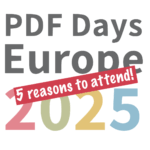Further quality requirements: PDF/X-Plus



by Stephan Jaeggi
PDF/X only defines the general requirements for a reliable exchange of prepress data; the ISO standard itself does not specify quality requirements. These requirements are different for each printing process (sheetfed offset, web offset, newspaper printing, flexo printing, screen printing, etc.) and market segments (magazines, newspaper, art books, etc.).
For example, PDF/X does not define a minimum resolution for imag.es. It simply requires that images are embedded (since external references are not allowed). There’s no reason why an image of 50 ppi can’t comply with the PDF/X specification because the required minimum resolution depends on the screen ruling as well as the screening technology (AM or FM screening), and varies with the print technology (ranging from newspaper print to printing on coated stock with high quality FM screening).
The ISO committee responsible for PDF/X made an early decision not to attempt to include quality requirements for every PDF/X use case, but to leave this task to organizations outside the ISO. Among other benefits, this approach makes quality requirements easier to update than if they were part of the official ISO standard (which requires approximately three years for a change).
Ghent (PDF) Workgroup
The Ghent (PDF) Workgroup (www.gwg.org) took over the task of defining quality requirements. Known informally as the “GWG”, the Ghent Workgroup, founded in 2002, is an international organization made up of graphic arts users, associations & developers building best practices for publishing and packaging workflows. Originally GWG developed so-called “PDF/X-Plus” specifications based on PDF/X-1a for more than a dozen market segments. These segments were reduced to seven in the latest GWG2015 specification for heatset and coldset printing:
- Magazine Ads
- Newspaper Ads
- Sheetfed CMYK
- Sheetfed Spot
- Web CMYK
- Web Spot
- Web CMYK News
The following quality requirements (among others) are defined by the Ghent Workgroup for each market segment:
- small text
- effective line width
- use of spot colors
- total ink coverage
- image resolution for grayscale and color images
- image resolution for 1-bit images
- overprinting
- PDF/X output intent
The GWG2015 specifications are based on PDF/X-4:2010, and for each market segment there are two variants:
- CMYK (and spot colors) only, and
- CMYK+RGB which also allows ICC-based RGB images.
ICC-based colors for vectors and text are not allowed in GWG2015 since they require the use of special color management technologies at the print shop (e.g., to get pure black text) which makes the files unpredictable. In addition, the use of ICC-based transparency blend modes is problematic in PDF/X-4 since the Adobe PDF Specification 1.6 on which PDF/X-4 is based doesn’t clearly specify how to process such objects.
The Ghent Workgroup has started working on an enhanced version allowing more color spaces and more color managed objects using PDF/X-6 (based on PDF 2.0) which will clearly define processing of transparency with color management.
In addition to the GWG2015 specification for commercial printing, the Ghent Workgroup has also released GWG2015 specifications for packaging. These are also based on PDF/X-4:2010 and cover the following variants:
- Packaging Offset
- Packaging Gravure
- Packaging Flexo
PDFX-ready in Switzerland
In 2005, the PDFX-ready association (www.pdfx-ready.ch) was founded in Switzerland. The main goal of this organization is to promote the use of PDF/X standards by creators and receivers of prepress data via easy instructions (called recipes), color and export settings for layout applications, and preflight profiles for reliable PDF/X workflows. The deliverables are freely available in German, French and (partially) in English at www.pdfx-ready.ch.
Since the goals of PDFX-ready are very similar to those of the Ghent Workgroup, PDF/X-ready joined the Ghent Workgroup and is a very active member. The preflight profiles of PDFX-ready are based on the GWG specifications but provide additional checks and information.
In addition, PDFX-ready offers a family of certifications for its members:
- Creator certification
- Output certification
- Expert certification
PDFX-ready also publishes the popular PDFX-ready Guideline (over 250,000 downloads), which is updated every year (available in German and English).
The latest developments are the PDFX-ready Online Tools which allow anyone to upload PDF files to a cloud server for PDF preflight using the PDFX-ready profiles, color preflight and a conversion from older color profiles to newer versions (ISO Coated V2 to PSO Coated V3 and vice-versa) using a free Connector for Mac and Windows.




